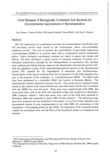Field Release of Biologically Contained Soil Bacteria for Environmental Applications in Bioremediation
JIRCAS international symposium series
| ISSN | 13406108 |
|---|---|
| 書誌レコードID(総合目録DB) | AA1100908X |

本文フルテキスト
intlsymp-5_21-30.pdf232.96 KB
The full exploitation of recombinant microbes for bioremediation of polluted sites will inevitably involve their release in the environment, where non-controllable conditions prevail. One way to increase the predictability of genetically engineered microorganisms (GEMs) is to provide them with a containment system biologically active. Active biological containment systems are based on genes that induce cell killing. We have developed a model system of chemical induction of suicide as a biological containment principle for the biodegradation of xenobiotics. The strategy used combines the killing function, based on the Escherichia coli porin-like protein Gef, with the regulatory system of the meta-cleavage pathway operon on the Pseudomonas putida TOL plasmid for the degradation of benzoates and alkylbenzoates. Transcription of the operon is driven from the Pm promoter by the XylS regulator, but only in the presence of the substrate, i.e., 3-methylbenzoate (3MB). Two field trials have been performed in a controlled 100m2 site located in Granada (Spain). The experimental subsets consisted of groups of pots. One group of pots contained seeds coated by the control or the contained bacteria, and other series of pots were inoculated with the GEMs but were not sown. Some pots were supplemented with 3MB. Zea mays seeds were used in the field trial, initiated in May and completed in September 1995 ("summer release"). Vicia faba seeds were used in the field trial initiated in December 1995 and completed in April 1996 ("winter release"). The following items have been analyzed and are described in this paper: (1) survival of the contained and uncontained strains in pots supplemented or not with 3MB, (2) colonization of the rhizosphere of developing plants by the GEMs, (3) dispersion of the bacterial strains outside the inoculation area, and (4) effect of the introduced strains on indigenous soil bacteria.
| 作成者 | Cayo Ramos Lazaro Molina M.Carmen Ronchel Soren Molin Juan L. Ramos |
|---|---|
| 公開者 | Japan International Research Center for Agricultural Sciences |
| オンライン掲載日 | |
| 号 | 5 |
| 開始ページ | 21 |
| 終了ページ | 30 |
| 言語 | eng |
